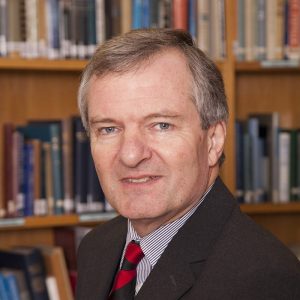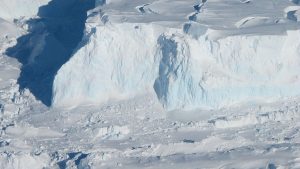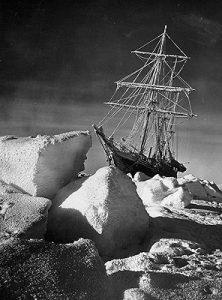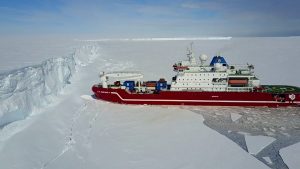While death and disease stalk nations & protests fill the streets, Nature will rock your world. New science shows the big ice sheets of Antarctica melted six times faster than now, just a few thousand years ago. Could sea level be pushed higher in just a few years? Back from his expedition, our guest is Professor Julian Dowdeswell, Director of the Scott Polar Research Institute at Cambridge. Then to Siberia, where “zombie” fires can rise out of the winter snow, & temperatures this spring are off the charts. Eyes-in-the-sky scientist Mark Parrington from the EU Copernicus service with a surprising take on global wildfires. Ready or not, the heat, storms and rising seas are showing up this year, and every year to come.
Listen to or download this Radio Ecoshock show in CD Quality (57 MB) or Lo-Fi (14 MB)
RAPID ANTARCTIC ICE SHELF MELT – SEA LEVEL RISE – JULIAN DOWDESWELL
We are beset by pandemic, unemployment, and social disorder. None of that stops the forces set in motion by our alteration of the land, seas and atmosphere . The clock of climate change is running, but how fast? Now from the far reaches of the world, we have evidence that vast ice shelves in Antarctica can retreat ten times faster than anything we see today. This is credible new science from the Scott Polar Research Institute at Cambridge University. It follows discoveries made from an ice-breaker on the far frozen side of Antarctica. There, advanced drones revealed a record of rapid ice retreat and not that long ago.

Professor Julian Dowdeswell, Director of the Scott Polar Research Institute, Cambridge.
From Cambridge, our guest is the Expedition Chief Scientist, Professor Julian Dowdeswell. He is reporting results from an amazing expedition to Antarctica last year, the Weddell Sea Expedition on board the South African ice breaker S.A. Agulhas II. They sailed to the coast off East Antarctica, where seas are among the most tumultuous and dangerous in the world.
Listen to or download this 28 minute interview with Julian Dowdeswell in CD Quality or Lo-Fi
The research ship managed to get into the area better because of breakaways of recent ice shelves, helping clear sea ice. This is key: sea ice, Dowdeswell tells us, is just the frozen surface of the ocean. When sea ice melts it adds nothing to global sea levels. Ice shelves by contrast are formed by layer upon layer of compacted snow accumulated over long periods of time. That ice may begin on the continent (land) of Antarctica, but it slowly flows out over the ocean, towering above the sea and extending down to the sea bottom.
Comparatively warmer water is getting under those ice shelves, lifting them with the tides, leaving “delicate” ridges on the sea bottom where they ground. As that grounding line retreats with the ice shelf retreat, these ridges could be seen – if there was any way to see them. Dowdeswell and other scientists launched sophisticated underwater drones with advanced echo sounders that create images of those grounding lines.
All this matters intensely because we need to know who fast those ice shelves are retreating, and what their maximum speed of retreat might be. That will determine when large parts of coastal mega-cities around the world will be hit with damaging storm surges, and then go underwater so often that humans will have to retreat toward higher ground.

During the 14 years I have been interviewing scientists, the general assumption is the retreat of Antarctic ice shelves, which carry enough water to add meters to sea level, would take thousands of years. Although large ice shelves like the Larsen B have dropped off during the last decades, the overall retreat has been comfortingly slow. That comfort is gone now. The last time the ice shelves pulled back was at the end of the great glaciation about 12,000 years ago. The pattern of ridges or old grounding lines is still imprinted on the sea bottom. Dowdeswell and team captured those records. It showed ice shelves can pull back several miles in a SINGLE YEAR. The “delicate ridges” showed a speed of ice shelf retreat six times faster than today. Remember, that did not happen on ancient Earth, but just a few thousand years before human cities and civilization began.
So far this science cannot tell us what the trigger point is for a collapse of Antarctic ice shelves, or the time when we should expect this to happen. There could be a sudden and very large sea level rise in a few decades, or a few centuries, or maybe a couple of thousand years from now. But now planners and modelers know this has happened and can happen again. Such a grave risk puts even more emergency power in our need to slash greenhouse gas emissions and run our energy system in reverse: to capture more carbon dioxide from the atmosphere than we emit.
Find the new science here: “Delicate seafloor landforms reveal past Antarctic grounding-line retreat of kilometers per year”, as published in the journal Science, on May 29th 2020.
FINDING “THE ENDURANCE”
A second part of the mission was to get a “photograph” of the famous wreck of the Endurance. That was the ship of Antarctic explorer Sir Ernest Shackleton, which went down crushed by ice in 1915. When the ship sank, it began one of the most inspiring survival and rescue stories of all time. The Endurance was like the Titanic of Antarctica.

As they abandoned ship, the Endurance crew marked the location using the stars and a Sextant. So the location was fairly well known. But no one has managed to get back there to find it. The Agulhas II is one of the world’s largest and most modern ice-breaking research ships. But even they had only a window of 36 hours to get through the pack ice and find the wreck of the Endurance. The team made it in, and launched the drone, which made it to the area where the ship went down. But in a sad twist, the drone failed to bring back the evidence. The Agulhas had to withdraw and Antarctica keeps that mystery again.

S.A. Arulhas II, the South African premier polar research supply vessel, built in Finland, commissioned in 2012.
WE NEED TO START OUR RETREAT FROM THE SEA NOW
The very big results of this Scott Polar Research expedition were realized however. It is an “Oh my God” moment in science. We just found out massive ice shelves as large as many European countries can release their burden of stored water to the ocean in a matter of years. It is now a known possibility. It has already happened.
This reminds me of my interview with Pankaj Khanna from Rice University. They found plateaus of coral off the coast of Texas showed sea level rise coming not in gradual increases (which coral can adapt to) but in large steps that drowned the coral (putting it too deep for photosynthesis). That was another sign that sea level rise may not be a slow ramp up, but may come in periods of shocking advance of the sea into land.
That alone should halt all the projects to build low-lying islands and extensions by filling in the sea. It should also motivate all coastal cities to begin mounting critical infrastructure higher up and away from the sea. Coastal nuclear reactors need to begin their shutdown process. We need alternatives for airports on the edge, found everywhere from Vancouver to San Francisco to many in China and beyond.
Read more about this new science in the popular press here (CNN), here (Gizmodo) and here (BBC).
===========================================================================================
WILDFIRES AS THE PLANET HEATS UP – MARK PARRINGTON
Siberia was blasting hot in May 2020, with some places almost 40 degrees Fahrenheit – 22 Celsius – above average. Locals described skipping a season, going straight from winter into a hot summer. Massive forest fires in northern Russia erupted in the heat, releasing their carbon into the atmosphere. Is this a case of global warming driving more global warming? During the pandemic it’s hard to get reports from the ground, but the satellite eyes-in-the-sky are still working.
I reached out to Mark Parrington, senior scientist and wildfire expert at the European Union’s Copernicus Atmosphere Monitoring Service or CAMS. Mark told us about smoke from Arctic fires in a Radio Ecoshock interview last September. Now Parrington and other experts worry these new fires, practically popping up out of the snow, survived the winter to burn again – zombie fires. But on the climate change angle, prepare to be surprised.

Dr. Mark Parrington, Copernicus
Listen to or download this 14 minute interview with Mark Parrington in CD Quality or Lo-Fi
The fire report from Mark Parrington turned out to be better news than I expected. The Copernicus satellite monitoring system has been reporting the numbers of fires of all kinds have been decreasing since accurate sensors began reporting in 2003. He also just told us emissions from wildfires has also been declining over the last 17 years. Let’s review. Parrington said:
“Overall, in a world-wide sense, fire activity and fire emissions are decreasing year to year. And this is mostly driven by fire activity in the tropics. The reason it is declining, or has been declining in a general sense since 2003 is because of how land practices and land management practices have been changing in the tropical region. So it’s true that in some countries we are seeing in recent years an upward trend in the fire activity. And in some places this upward trend has been observed for a much longer period of time – so for example, from California and Alaska they are seeing generally an increasing trend in the number of extreme fires. But then there are a lot of places around the world where actually the trend is either flat or declining.”
I found this hard to believe, running against my own experience, and what we have heard from other forest experts. Satellites don’t lie, but should we accept these conclusions about declining emissions. And does that mean that wildfires are not adding carbon to the atmosphere, leading to more global warming? By the way, Parrington did not say that.
To start, we need to remember the old story of blind men experiencing an elephant for the first time. Each described the elephant like the part they were holding, whether a tail or a massive leg. My radio studio is located in British Columbia, on Canada’s west coast. We just went through two extreme fire years, declared emergencies back-to-back. The risk was high, smoke too dense to breath outside, and we had to prepare to evacuate at any time. So I have a personal lens worrying about fires burning in the world, and I bet people living in other fire hot spots from Siberia to the Amazon to Australia feel the same.
The world statistics gathered by satellites say fires are actually decreasing, mainly due to changes in agriculture and fire management in the tropics, where biomass is greatest. Of course those global averages do not mean a lot to people in Indonesia who choked in smoke year after year. I have other concerns. For example, can we just count the number of fires without including fire intensity. Wildfires in California added twice as much carbon to the atmosphere as all their fossil fuel burning in one year.
The Copernicus Atmosphere Monitoring Service website is here. Find the Copernicus Climate Change Service website here.
Get more information on Copernicus here.
TWO FIRE EXPERTS WEIGH IN
I contacted one of the best fire experts David Bowman from the University of Tasmania. He’s been a great guest on Radio Ecoshock, along with another great fire scientist, Mike Flannigan from the University of Alberta. David Bowman quickly replied to my email about this Parrington interview, saying this:
“I am of the view that forests are drifting to sources of carbon. I find a lot of remote sensing folks are not really understanding what is happening on the ground, true there are areas with declining area burnt (often savannas) but that is only part of the story. The question is one of the severity (the impact on vegetation) and frequency of fires that affects the ability of forests to retain carbon. There is no question the boreal forests are vulnerable to switching to sources because the soil carbon is becoming available for fuel and the regions is warming and there are more lightning starts. Here in temperate Australia we are seeing a relentless increase in large intense fires associated with drought, the forests are not bouncing back because of drought and the increase in the frequency of fires (many lightning ignited). But the lack of good data on biomass changes, long term (well before satellite era) data make it hard to be certain of anything. So the caveat here is about evidence, and not jumping to conclusions by the absence of evidence (which is not evidence of absence) or one sliver of evidence. The satellite record is very short, the models of emissions are crude so I would not bet my house (or planet) on them alone. We need much more data from field reality.”
That was from a personal email from David Bowman, at the University of Tasmania.
If I did bet my home on fire advice, it would come from fire expert Mike Flannigan. Professor Flannigan warned on this show the emerging extreme danger of fire during climate warming. His advice is widely sought. Mike concurred with Dr. Bowman:
“I agree with David.
Most years in Canada our forests are sources of carbon due to disturbances (fire and insects primarily). Talk to Werner Kurz if you want to pursue that. Yes, global area burned has decreased but probably more than balanced by fire severity ( depth of burn) in other regions. If you look at many forests over the long term they are close to carbon neutral unless there is a change in state( forest to grassland). However, peatlands have been carbon sinks for millennia but are now more vulnerable to wildland fire due to increased aridity in many parts of the world. These peatlands have about a third of the terrestrial carbon and can release significant amounts of greenhouse gases ( paper by Susan Page on Indonesian fires in Nature around 2001). Much of the global peatlands are in the boreal that has a significant increase in area burned. Also, there is an interaction between warming – fire and the thawing of permafrost.
Lastly, satellite observations have lots of caveats and our models are not good enough yet so we need more observations and more research ( a common refrain with researchers).”
Here is another critical issue: even if emissions from wildfires are declining, that does not suggest they are not adding greenhouse gases, and global warming. To be fair, I had a whole series of questions about this role of carbon and fires, which Mark Parrington declined to answer. Like all honest scientists, Mark did not want to go outside his definite expertise. I really need to take this up with the carbon counters, and dig into more research.
Even a Google search shows the big questions about fire and climate change are still either unknown or disputed. There are two major organizations monitoring wildfires and carbon, and they produce different, some would say contradictory information. Check out this from Yale360 at Yale University:
“[One database] Global Forest Watch (GFW), is compiled from satellite images by the World Resources Institute, a Washington think tank. It paints a gloomy picture, putting the decline in tree cover last year at 72.6 million acres, almost 50 percent more than in 2015. That analysis is supported by on-the-ground observations, especially in Southeast Asia, where forest continues to be converted to oil palm.
The other main source for deforestation data, the Global Forest Resources Assessment (FRA), which is compiled from government inventories by the Rome-based UN Food and Agriculture Organization, is less bleak. It estimates the annual net loss, once forest regrowth is taken into account, at barely a tenth as much: just 8.2 million acres. And it says deforestation rates have declined by more than 50 percent in the past decade.”
Mark Parrington previously appeared on Radio Ecoshock in the September 18, 2019 show Death in the Bahamas & Smoke Over the Arctic
I also found this article very helpful: “Intense Boreal Forest Fires a Climate Concern” by Sarah Ruiz Sarah Ruiz – February 13, 2020. The Capital Weather Gang at the Washington Post covered the “zombie” fire story here:”‘Zombie fires’ are erupting in Alaska and likely Siberia, signaling severe Arctic fire season may lie ahead.”
In this new show I play a brief report from the excellent Canadian radio program Quirks and Quarks. The clip discussed “How do CO2 emissions from forest fires compare to those from fossil fuels?” and features Dr. Werner Kurz, Senior Research Scientist with Natural Resources Canada.
The whole issue is complex. For example, satellite images are good at detecting when forest disappear after fires or logging, but poor at sensing their slow and patchy rate of return. Nor can the satellites tell us if the returning vegetation can capture as much carbon or sequester it as long as the original forest. Plus, forest fire smoke actually cools the planet somewhat for up to a year, reducing the warming we might have expected.
TWO BOTTOM LINES FOR WILDFIRES AND CLIMATE
For me there are two bottom lines. The first is that the forest is much more than carbon. Studies continue to warn that species are going extinct as forests are cut down and/or burned. And human lives are scarred by fire fear. But the second take-away is simple: are forest fires adding more carbon to the atmosphere than is being reabsorbed by new growth, or by other sinks like the ocean? My non-scientific general survey finds agreement that fires are a significant factor in warming, accounting for up to 8% of global greenhouse gas emissions each year. If true, 8% is still minor compared to the really big source of damaging carbon into the atmosphere: humans burning fossil fuels.
As summer heats up here in the Northern hemisphere, we have our evacuation bag still packed in case fire burns over the hills. But during a pandemic, where would we go? How could fire fighters camp and work battling both fire and COVID-19? New studies report that pollution makes COVID-19 more lethal, as does smoking. Will wildfire smoke make the pandemic worse.
Check out this helpful article: “How Bad Is the Climate Feedback from Fires?” from Inside Climate News.
Reporting from the fire zone, I’m Alex Smith. Please help support the free world-wide distribution of this program if you can.
Thank you for listening and caring about our world. Please join us again next week for more Radio Ecoshock.
=====================================================================================
WILL SOME SCIENCE SHUT DOWN BECAUSE OF THE PANDEMIC?
I asked my last two guests, including Professor Dowdeswell from Cambridge about a possible decline in science as Universities are closed, and expeditions to measure things all over the world are suspended due to the pandemic. I am seeing fewer climate papers coming through my science alert services, and those currently appearing were a year or more in preparation. We may see less available in the fall or next winter.
I am also concerned that some kind of records that are taken on the ground, being built up over many years of measurements or observations, will develop a gap in 2020 due to limits on travel and group science. Add in perilous finances for closed universities, the probability of fewer students, and certainly fewer overseas students that really fund a lot of North American universities, and we may see a hole develop in our knowledge gathering systems.
Dowdeswell did say the European Geophysical Union meeting in May, normally in Vienna, was tried online – but he found it less successful, in part due to the difficulty of linking up 200 people using different platforms, in various time zones, often from their homes. I think the now-postponed Scotland COP should be tried online – because we don’t have a year when we can postpone climate action. Others say the COP has presided over constant increase in CO2 in the atmosphere, so holding it or not won’t make much difference.
=======================================================================================
INTERESTED IN FOOD FOR UNCERTAIN TIMES? CHECK THIS OUT…
From the folks at Post Carbon Institute you can watch this recent presentation “Recipe for Action: Building Food Security in Insecure Times”
“Hear what Danielle Nierenberg, Co-founder and President of Food Tank, Saru Jayaraman, President of One Fair Wage, and Melissa DeSa, Working Food Community Programs Director have to say about the failures of our global food system, how the largest segment of working America has been left without food and economic safety nets, and inspiring ideas for improving food security in our own communities.”